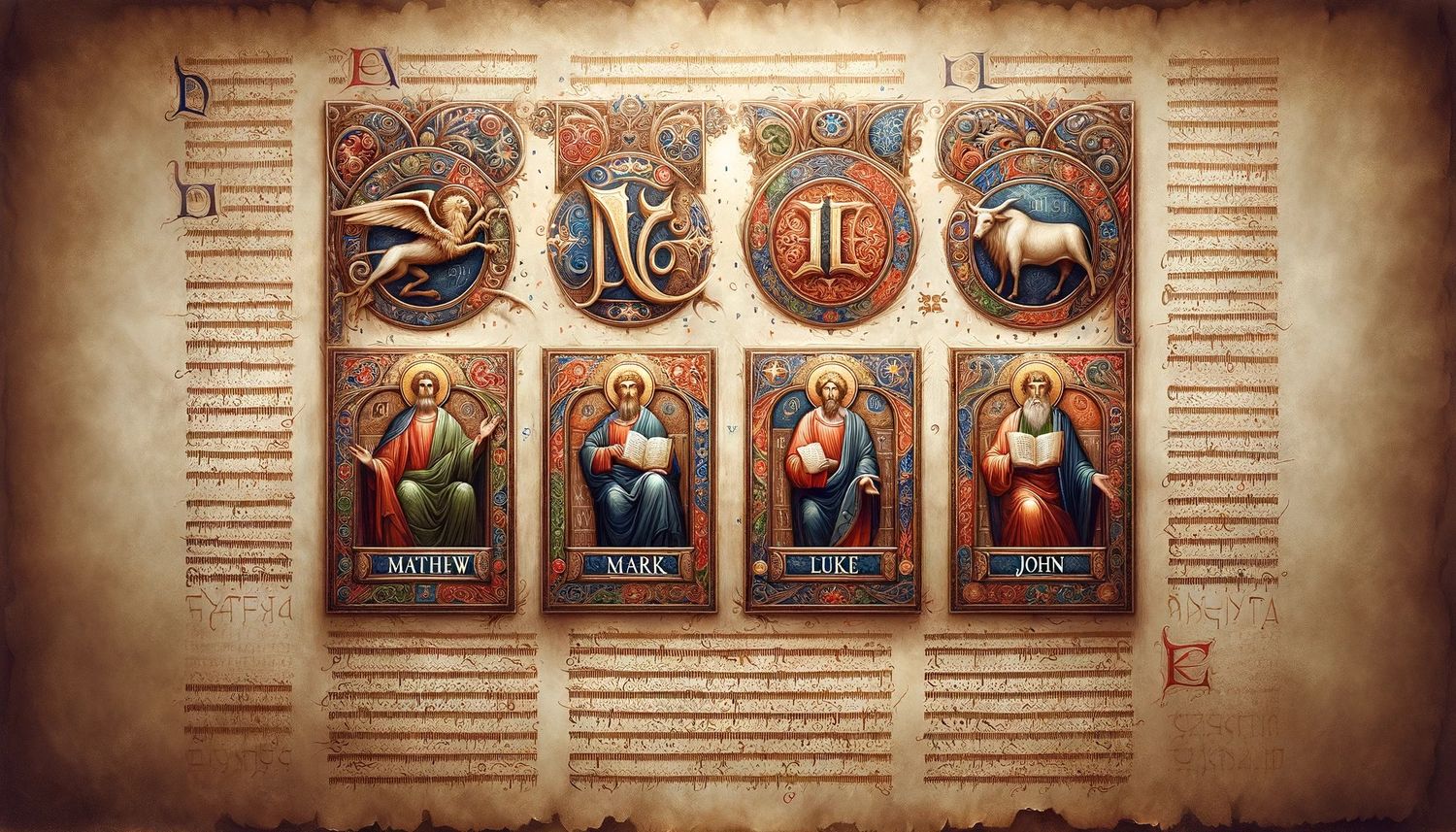Home>Christian Videos>Bible Stories>How Many Gospels Are In The Bible


Bible Stories
How Many Gospels Are In The Bible
Published: March 6, 2024
Peter Smith, Editorial Director at Christian.net, combines deep insights into faith, politics, and culture to lead content creation that resonates widely. Awarded for his contributions to religious discourse, he previously headed a major organization for religious communicators, enhancing dialogue on faith's societal impacts.
Discover the number of gospels in the Bible and explore the fascinating stories within its pages. Uncover the rich history and teachings of the Bible through its diverse narratives. Explore now!
(Many of the links in this article redirect to a specific reviewed product. Your purchase of these products through affiliate links helps to generate commission for Christian.net, at no extra cost. Learn more)
Table of Contents
Introduction
How many Gospels are in the Bible? The Bible contains four canonical Gospels, which are Matthew, Mark, Luke, and John. These Gospels are considered to be the authoritative accounts of the life, teachings, death, and resurrection of Jesus Christ. However, there are also several apocryphal Gospels that are not included in the Bible but are still of interest to scholars and individuals interested in early Christian literature. In this article, we will explore the canonical Gospels as well as some of the apocryphal Gospels and their significance in the study of Christianity.
Read more: How Many Gospels In The Catholic Bible
The Four Canonical Gospels
The four canonical Gospels, Matthew, Mark, Luke, and John, are the first books of the New Testament in the Christian Bible. Each Gospel provides a unique perspective on the life and teachings of Jesus Christ, offering valuable insights into his ministry and the early Christian community. These Gospels are considered canonical, meaning they are officially accepted as part of the biblical canon and are widely recognized as authoritative accounts of Jesus' life and teachings by most Christian denominations.
1. The Gospel of Matthew
The Gospel of Matthew is traditionally attributed to the apostle Matthew, a tax collector who became one of Jesus' twelve disciples. This Gospel emphasizes Jesus as the fulfillment of Old Testament prophecies and presents him as the long-awaited Messiah. It also contains the famous Sermon on the Mount, which includes the Beatitudes and teachings on various aspects of Christian discipleship.
2. The Gospel of Mark
The Gospel of Mark is believed to be the earliest written Gospel and is attributed to John Mark, a companion of the apostle Peter. Mark's Gospel focuses on Jesus' actions and miracles, portraying him as a powerful and enigmatic figure. It is known for its fast-paced narrative and emphasis on the suffering and humanity of Jesus, particularly in the events leading up to his crucifixion.
3. The Gospel of Luke
The Gospel of Luke, written by Luke the physician, provides a detailed and comprehensive account of Jesus' life, ministry, and teachings. Luke's Gospel is characterized by its attention to historical and social context, as well as its emphasis on Jesus' compassion for the marginalized and outcasts of society. It also contains unique parables and stories, such as the parables of the Good Samaritan and the Prodigal Son.
Read more: How Many Verses Are In The Gospels
4. The Gospel of John
The Gospel of John stands apart from the synoptic Gospels (Matthew, Mark, and Luke) in its theological and literary style. It presents a highly symbolic and reflective portrayal of Jesus, focusing on his divine nature and the significance of belief in him as the Son of God. John's Gospel contains the famous "I am" sayings of Jesus and emphasizes the themes of light, life, and love as essential aspects of the Christian faith.
These four canonical Gospels collectively provide a multifaceted and comprehensive understanding of the life, teachings, death, and resurrection of Jesus Christ, forming the cornerstone of Christian belief and practice.
The Apocryphal Gospels
The Apocryphal Gospels refer to a collection of early Christian writings that are not included in the New Testament but offer alternative perspectives on the life and teachings of Jesus. These Gospels are often referred to as apocryphal, meaning "hidden" or "secret," and they have been the subject of scholarly interest and debate due to their diverse and sometimes controversial content. While these Gospels are not considered authoritative by mainstream Christian traditions, they provide valuable insights into the diversity of early Christian beliefs and the rich tapestry of literature that emerged within the early Christian movement.
1. The Gospel of Thomas
The Gospel of Thomas is perhaps the most well-known and studied apocryphal Gospel. Discovered in 1945 as part of the Nag Hammadi library in Egypt, this Gospel consists of a collection of sayings attributed to Jesus, rather than a narrative account of his life. The sayings in the Gospel of Thomas offer a glimpse into the wisdom teachings of Jesus and have sparked significant interest among scholars of early Christianity and Gnostic studies. The Gospel of Thomas presents a unique perspective on Jesus' teachings and has contributed to discussions about the diversity of early Christian thought.
2. The Gospel of Judas
The Gospel of Judas gained widespread attention following its translation and publication in the early 21st century. This Gospel presents an alternative portrayal of Judas Iscariot, traditionally known for betraying Jesus. In the Gospel of Judas, Judas is depicted as a trusted disciple who carries out a secret plan at Jesus' request, leading to Jesus' crucifixion and subsequent liberation of his spiritual self. The Gospel of Judas offers a provocative reinterpretation of Judas' role in the events surrounding Jesus' death and has sparked discussions about the complexities of early Christian beliefs and the diversity of perspectives within the early Christian movement.
Read more: How Many Parables Are In The Gospels
3. The Gospel of Mary Magdalene
The Gospel of Mary Magdalene is another apocryphal Gospel that has garnered attention for its portrayal of Mary Magdalene, a figure closely associated with Jesus' ministry. This Gospel presents Mary Magdalene as a prominent disciple and recipient of special teachings from Jesus. The Gospel of Mary Magdalene has contributed to discussions about the role of women in early Christianity and has sparked interest in reevaluating Mary Magdalene's significance within the Christian tradition.
These apocryphal Gospels, among others, offer valuable insights into the diverse beliefs, perspectives, and literary expressions within early Christianity. While they are not included in the biblical canon, they continue to stimulate scholarly inquiry and enrich our understanding of the dynamic and complex world of early Christian literature.
The Gospel of Thomas
The Gospel of Thomas is perhaps the most well-known and studied apocryphal Gospel. Discovered in 1945 as part of the Nag Hammadi library in Egypt, this Gospel consists of a collection of sayings attributed to Jesus, rather than a narrative account of his life. The sayings in the Gospel of Thomas offer a glimpse into the wisdom teachings of Jesus and have sparked significant interest among scholars of early Christianity and Gnostic studies. The Gospel of Thomas presents a unique perspective on Jesus' teachings and has contributed to discussions about the diversity of early Christian thought.
The Gospel of Thomas is structured as a compilation of 114 sayings, or logia, attributed to Jesus. These sayings are presented without narrative context, and they cover a wide range of topics, including spiritual wisdom, the nature of the divine, and the path to enlightenment. Unlike the narrative Gospels, which focus on the life and actions of Jesus, the Gospel of Thomas provides a collection of enigmatic and thought-provoking sayings that invite contemplation and reflection.
One of the distinctive features of the Gospel of Thomas is its emphasis on the concept of self-discovery and inner transformation. Many of the sayings in this Gospel center on the idea of seeking knowledge and insight within oneself, suggesting that the path to spiritual enlightenment lies in self-awareness and introspection. This emphasis on inner wisdom and self-realization sets the Gospel of Thomas apart from the narrative Gospels and has led to discussions about its potential connections to Gnostic and mystical traditions within early Christianity.
The Gospel of Thomas has also raised questions about the diversity of early Christian beliefs and the transmission of Jesus' teachings. Some scholars have suggested that the sayings in the Gospel of Thomas may represent an independent tradition of Jesus' wisdom teachings, separate from the narratives found in the canonical Gospels. This has sparked debates about the oral and written sources that contributed to the formation of the Gospels and the rich tapestry of early Christian literature.
Overall, the Gospel of Thomas offers a fascinating glimpse into the diverse and complex world of early Christian thought and spirituality. Its collection of sayings provides a unique perspective on the teachings of Jesus and has stimulated scholarly inquiry into the richness and diversity of the early Christian movement. While not included in the New Testament, the Gospel of Thomas continues to be a source of inspiration and contemplation for those interested in exploring the wisdom and spiritual insights attributed to Jesus in the early Christian era.
The Gospel of Judas
The Gospel of Judas gained widespread attention following its translation and publication in the early 21st century. This Gospel presents an alternative portrayal of Judas Iscariot, traditionally known for betraying Jesus. In the Gospel of Judas, Judas is depicted as a trusted disciple who carries out a secret plan at Jesus' request, leading to Jesus' crucifixion and subsequent liberation of his spiritual self. The Gospel of Judas offers a provocative reinterpretation of Judas' role in the events surrounding Jesus' death and has sparked discussions about the complexities of early Christian beliefs and the diversity of perspectives within the early Christian movement.
The Gospel of Judas provides a unique perspective on the relationship between Jesus and Judas, challenging the traditional understanding of Judas as a villainous figure. Instead of portraying Judas as a traitor, this Gospel presents him as a key figure in fulfilling a divine plan orchestrated by Jesus. According to the Gospel of Judas, Jesus entrusts Judas with the secret knowledge necessary to carry out the plan, emphasizing Judas' role as a collaborator rather than a betrayer. This alternative portrayal of Judas has prompted reevaluation of his character and the dynamics of the relationships among Jesus and his disciples.
One of the central themes of the Gospel of Judas is the concept of spiritual enlightenment and liberation. The Gospel portrays Jesus as a spiritual teacher who imparts esoteric knowledge to Judas, enabling him to participate in a sacred mission that transcends conventional understanding. Through the lens of the Gospel of Judas, Judas' actions are reinterpreted as essential to the fulfillment of a higher purpose, challenging prevailing interpretations of his betrayal and shedding light on the complexities of divine providence and human agency.
The Gospel of Judas has sparked scholarly inquiry into the diversity of early Christian beliefs and the theological implications of alternative perspectives on familiar biblical narratives. It has raised questions about the fluidity of religious ideas and the multiplicity of interpretations within the early Christian movement. By presenting a counter-narrative to the traditional portrayal of Judas, this Gospel invites reflection on the complexities of human motives, divine intentions, and the enigmatic figure of Judas Iscariot within the broader tapestry of early Christian literature.
In summary, the Gospel of Judas offers a thought-provoking reimagining of a familiar biblical figure and challenges readers to reconsider long-held assumptions about the nature of betrayal, redemption, and divine purpose. Its alternative portrayal of Judas and its emphasis on esoteric knowledge and spiritual liberation contribute to the ongoing dialogue about the diversity of early Christian thought and the complex interplay of theological perspectives within the early Christian movement.
The Gospel of Mary Magdalene
The Gospel of Mary Magdalene is another apocryphal Gospel that has garnered attention for its portrayal of Mary Magdalene, a figure closely associated with Jesus' ministry. This Gospel presents Mary Magdalene as a prominent disciple and recipient of special teachings from Jesus. The Gospel of Mary Magdalene has contributed to discussions about the role of women in early Christianity and has sparked interest in reevaluating Mary Magdalene's significance within the Christian tradition.
The Gospel of Mary Magdalene offers a unique perspective on the role of women in the early Christian movement. In this Gospel, Mary Magdalene is depicted as a disciple who receives private teachings from Jesus, leading to speculation about her potential role as a spiritual leader or prominent figure within the early Christian community. The Gospel of Mary Magdalene challenges traditional gender dynamics and has prompted discussions about the diverse roles of women in the spread of early Christian teachings.
One of the central themes of the Gospel of Mary Magdalene is the emphasis on spiritual insight and inner knowledge. Mary Magdalene is portrayed as a recipient of esoteric teachings from Jesus, suggesting that she possesses a deep understanding of spiritual truths that transcends conventional wisdom. This portrayal of Mary Magdalene as a bearer of hidden knowledge has sparked interest in her potential role as a symbol of mystical wisdom and spiritual enlightenment within early Christian traditions.
The Gospel of Mary Magdalene has also raised questions about the relationship dynamics within the circle of Jesus' disciples. The special attention given to Mary Magdalene in this Gospel has led to discussions about her significance in the inner circle of Jesus' followers and the potential implications of her unique role. The Gospel of Mary Magdalene invites reflection on the complexities of interpersonal relationships and the diverse forms of discipleship present within the early Christian movement.
Overall, the Gospel of Mary Magdalene offers a compelling portrayal of a prominent female figure within the early Christian tradition and has sparked discussions about the roles of women, the transmission of esoteric knowledge, and the dynamics of discipleship in the early Christian movement. Its emphasis on the unique teachings received by Mary Magdalene and her potential significance as a spiritual leader has contributed to ongoing explorations of gender, spirituality, and leadership within early Christian communities.
Read more: How Many Words Are In The Gospels
Conclusion
In conclusion, the Bible contains four canonical Gospels—Matthew, Mark, Luke, and John—that are widely recognized as authoritative accounts of the life and teachings of Jesus Christ. These Gospels form the cornerstone of Christian belief and provide diverse perspectives on the significance of Jesus within the early Christian movement. Additionally, the apocryphal Gospels, such as the Gospel of Thomas, the Gospel of Judas, and the Gospel of Mary Magdalene, offer alternative insights into the teachings and relationships associated with Jesus and his disciples. While not included in the biblical canon, these apocryphal Gospels have sparked scholarly inquiry and enriched our understanding of the diverse beliefs and perspectives within early Christianity. The study of both the canonical and apocryphal Gospels contributes to a comprehensive exploration of the rich tapestry of early Christian literature and the complexities of the Christian tradition.












